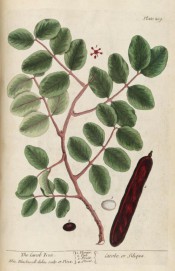Ceratonia siliqua L.
Frost-tender, evergreen tree or small shrub with a rounded head, dark green, leathery, pinnate leaves, with up to 10 leaflets, and cylindrical racemes of red and yellow flowers in late summer and autumn. To 15m. [RHSD, Hortus, Hilliers’].
Horticultural & Botanical History
Commonly believed to be the ‘Locust fruit’ of scriptures. ‘The dry pulp in which the seeds are buried is very nutritious, and is supposed to have been the food of St. John in the wilderness; wherefore it is called the Locust-tree, and St. John’s Bread.’ John Lindley, quoted in Johnson’s Dictionary. ‘Its sweet pods are often sold in London under the name of Locust fruit.’ [Gard. Chron. 1841]. ‘According to the Kew catalogue [it] has been an inhabitant of our gardens 239 years: but neither Mr. Aiton nor Mr. Miller had ever seen it blossom.’ However, it did flower at the Cambridge Garden ‘at the beginning of last February.’ The Locust fruit were clearly imported from warmer climes. [ABR pl.567/1809]. Don. Blackwell pl.209/1737.
History at Camden Park
Listed in all published catalogues [T.292/1843]. There are many mature trees in the gardens.
Notes
Published Dec 13, 2009 - 03:17 PM | Last updated Jul 18, 2010 - 04:59 PM
| Family | Fabaceae |
|---|---|
| Category | |
| Region of origin | Southern Europe |
| Synonyms | |
| Common Name | Carob, St. John?s bread, Locust, Algaroba |
| Name in the Camden Park Record |
Ceratonia siliqua - Carob, St. John’s Bread, Locust etc. |
| Confidence level | high |
